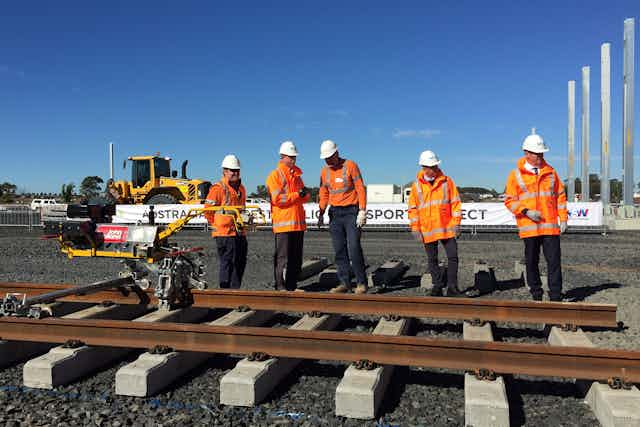At first glance you’d be forgiven for thinking the new Sydney Metro rail line will turn the suburbs between Sydenham and Bankstown into an urban paradise.
Amid cheerful community facilities and cycle paths, the Department of Planning’s zoning brochure shows a colourful mass of new higher-density zones. Every town centre along the route – including Campsie, Lakemba, Canterbury and Belmore – is in line for a facelift. A raft of new apartment towers, pavement cafes and boutiques will crowd around the Metro stations.
All cities need renewal and no-one would argue that this part of Sydney isn’t crying out for it. However, the Baird government needs to explain what the changes will mean for existing residents. Compared with the rest of the city, they are typically poor, older and renters. What’s in it for them?
And who’ll profit from the value uplift that will flow from the massive investment of taxpayers’ funds, both from higher land values resulting from the new density and from being snug up against a new Metro line?
These are just two of the outstanding questions to which the government should already have articulated some answers. That’s because, as each day passes, developers are doing their maths based on the existing scenario set out by the Department of Planning. Soon it will be too late to retrofit any changes.
Where do existing residents fit in?
To understand the reality, it’s worth taking a closer look at the area along this stretch of the new Metro.
The Sydenham-to-Canterbury corridor is home to one of the largest concentrations of lower-income renters in Sydney, compounded by a large population of retirees on fixed, low incomes. Gentrification, the driver for urban renewal across much of Sydney, has not come knocking on these doors – yet.
So, what percentage of the 36,000 new apartments and other dwellings along the renewal corridor has been allocated for affordable housing? We can be sure they won’t be pitched at the pockets of those who live there now.
And as new investment comes in, so rents will rise. Without a significant affordable housing component, many of the essential workers who live there today – the mechanics, care attendants and shop workers – will be pushed further towards Sydney’s periphery. That will leave the rest of the city struggling to get the lower-paid workforce it needs to function productively.
In comparable renewal projects in cities like London and New York, a significant proportion of new stock is set aside as affordable housing, precisely to avoid such problems. It’s accepted as completely reasonable that lower-income working families should also benefit from new housing delivered as a result of public investment.
The Baird government must make it clear to developers exactly what proportion of the new homes will be set aside for this purpose – and quickly. The case for a zoning policy that mandates a proportion of all new homes as affordable has never been clearer.
The government also needs to show us where it is placing services, such as the new schools that the expanded population will need. With the government’s zoning map not identifying where these services will go, land-owners will rightly question any subsequent proposal for a school or park that would diminish their profits from possible residential development.

The government has not yet provided any explanation of the expected amount of the massive value uplift that will come from the Metro and all the amenity upgrades.
Nor have we been told whether any of it will be used to fund the Metro itself or investment in the infrastructure that will be needed to make this extensive new precinct vibrant and liveable – let alone whether it will be used to provide for affordable housing.
A model for inclusive renewal
Let me suggest a way the government can tackle all this.
We need a new model of inclusive renewal. Why not establish an arm’s-length, non-profit corporation to work in consortia or joint ventures with councils, landowners, businesses, residents (particularly in older strata properties), developers and the community housing sector?
Innovative funding for new infrastructure could come through hypothecated value-capture mechanisms. These could take the form of up-front levies on land and property sales and public borrowing supported by the increased local rates that will be collected. In this way the value uplift will be properly shared and paid for over the longer term.
Planning should be devolved to the newly amalgamated council in line with the district plans being drawn up by the Greater Sydney Commission. Affordable housing would be the responsibility of community housing providers, working with developers and the new agency. The model would also apply to other town centre and corridor renewal projects.
The new Sydney Metro promises a revolution in mass transit. However, the accompanying renewal of this corridor will affect one of the most socially and economically disadvantaged communities in Sydney. Perpetuating – or indeed enhancing – that disadvantage through wide-scale displacement and unaffordable apartment building would be disastrous.
This new urban paradise must not be just for those with deep pockets.

